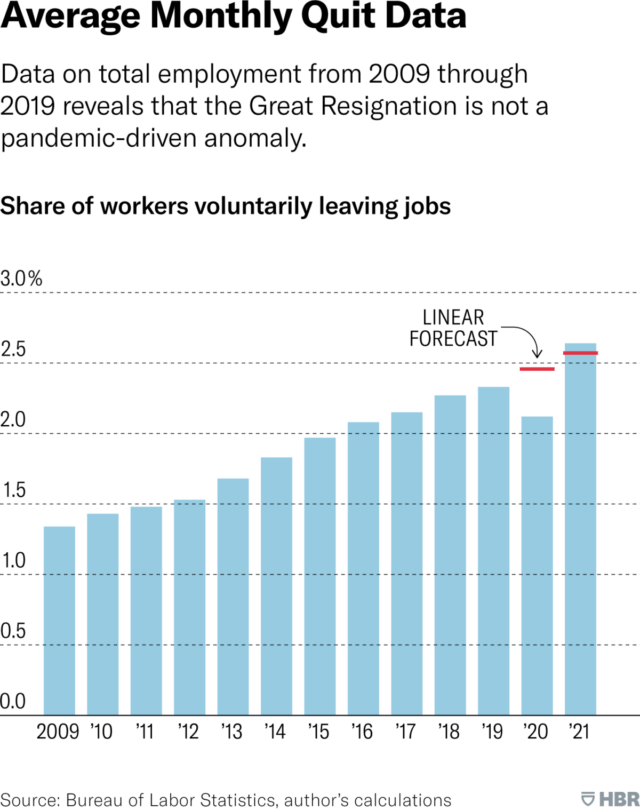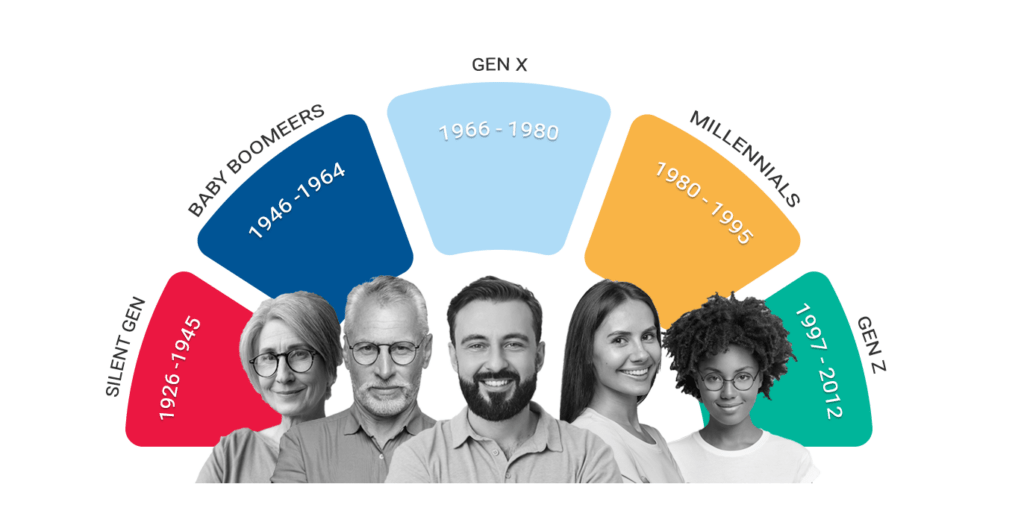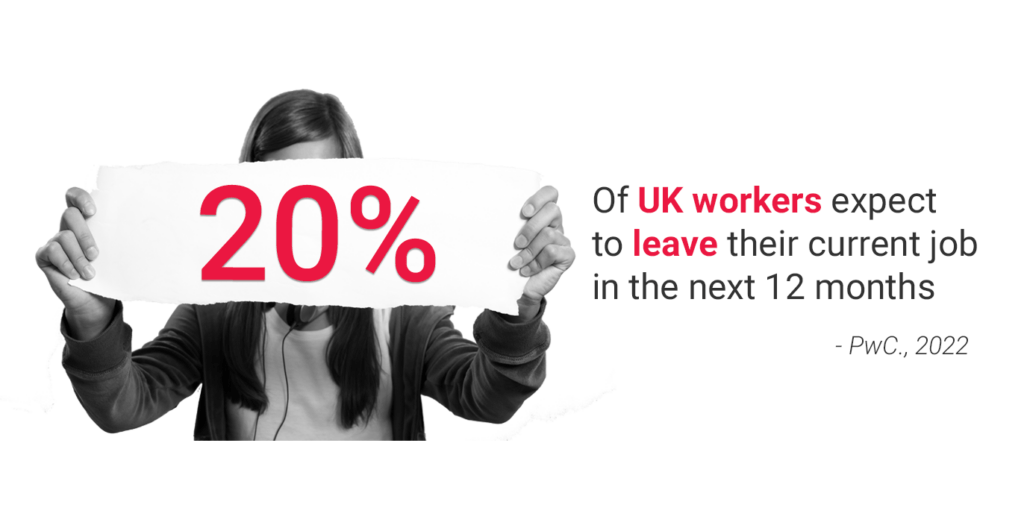
You’ve probably heard the theory that the pandemic is the real reason behind the Great Resignation. Sure, the pandemic has encouraged some employees to change how they think about work and re-evaluate what they want from work. But is the pandemic the only reason behind these resignations? And what does the evidence suggest?
Let’s answer this together.
We’ve gathered data from some of the most recent studies to find some answers.
So, here’s what everyone should know today about the Great Resignation.
A – Are the Waves of the Great Resignation Over?
Is the beginning of a cooling-off nearby? Or could we expect a new wave of resignations?
The truth is, it’s still hard to say. But for now, if leaders don’t recognise the importance of closing the gap between how employees are currently working and what really motivates them, turnover rates will continue to grow.
Let’s look at what is driving these high turnover rates.
B – The Big Quit
The Great Resignation, also known as the Big Quit, is the economic trend that includes a large number of employees voluntarily leaving their jobs. This trend appeared at the beginning of 2021 and impacted many industries and organisations worldwide.
C – Covid Pandemic
The pandemic has clearly made a significant impact on people, industries, and markets. It brought some negative and positive changes. In fact, poor response to the pandemic by some companies has undoubtedly made some employees more vulnerable and stressed.
It made them rethink their personal and professional life and changed their perspective on well-being and free time.

So, is the Great Resignation a negative Covid phenomenon or simply just a new trend?
D – The Decrease in Redundancies
As restrictions eased and things started to get “back to normal”, many people expected (hoped) for the wave of resignations to slow down.
According to some studies, there is a decrease in redundancy compared to 2021. However, we still see record numbers of employees voluntarily quitting their jobs in search of more fulfilling roles.

So, could this be evidence that Great Resignation didn’t really start with the pandemic?
Let’s answer this by looking at how the following factors contributed to the Great Resignation.
E – Employee Expectations Have Changed
The workforce’s mindset across different industries has changed significantly over the last few years. Revised or new business models that include things like flexible working, digital workplace services or collaboration tools have opened new possibilities and sparked new employee expectations.
So, what should the new workplace strategy include?
As simple as it may seem, closing the gap between how people get things done in their personal lives and how they get things done in the workplace can help you shape better employee experiences.
Discover 5 Ways to Improve Employee Experience
F – Flexible Working Is a Must
Inflexible working arrangements are one of the key reasons people are so open to looking for new jobs and even changing their career paths.
According to some studies, 62% of respondents are open to a mix of in-office and remote working, which puts flexible hybrid working on top as the preferred future way of work.
G – Generation Z is fuelling the Great Resignation?

Who is fuelling the Great Resignation? Is it Gen Z, Millennials or Gen X? And who benefits the most from it?
Many of you might think that Gen Z is winning the Great Resignation, and you might be right.
LinkedIn research shows that Gen Z’s job transitions in April 2022 were 29.5% higher than it was in 2021. Research further indicates a 9.6% increase in Millennials’ job transitions, while Gen X saw a rise of 8% in April 2022 compared to April 2021. The Bank of America Institute report shows similar results, with Gen Z being the generation with the highest percentage of job transitions.
So, does that means that Gen Z’s are benefiting the most?
The truth is that Gen Z is a generation of young professionals who value their free time, flexibility, reasonable compensation and finding the right job.
Ultimately, no matter who is ‘fuelling’ these resignations, the nature of work has changed – and most people are simply looking for new opportunities to grow.
H – Higher rates of quitting in women?
So now, you might ask, what does the resignation change rate by gender looks like?
According to Visier, women are quitting at higher rates than men. This trend actually pre-dates the Great Resignation but has accelerated in 2021.

But why?
It’s hard to say. There could be many reasons for this. The expectations for women outside their workplace are different, so feeling overwhelmed or overworked could be just one of the many factors for seeking some changes, along with salary and career opportunity parity which are still real issues.
I – Intent to quitting was present in 2020
Many studies show that the intent to quit jobs grew before the pandemic. In fact, it’s a long-term trend. From 2009 to 2019, the average monthly quit rate increased by 0.10 percentage points each year. Why? Employees were already dissatisfied with many organisations’ unsupportive environment and poor company culture.
So even when they survived the layoffs in 2020, this made them on the edge of quitting the next year.
J – Job dissatisfaction
Why are employees so unsettled? Is it because they were exposed to many changes and requirements in the last two years? Or does their perspective on the job simply change?
We could say that it’s a combination of all. Today, employees seek personal fulfilment and purpose at work. They want to be productive by working in a way that best suits their personal and professional life. Dissatisfaction with the work environment, taking on additional responsibilities with no additional salary, career progression, company culture or poor leadership increases their intent to leave their job.
So, what should employers do about this?
According to SDI research focusing on employee retention is a key consideration in 2022. So, organisations should shift their focus to the employee-centric workplace or a working model that includes flexible working hours, more productive meetings and gathering feedback from employees.
K – Knowledge, skills, and abilities
As a result of COVID-19 and more time, in general, to think about the future of work, many people are now open to gaining new skills, knowledge and re-skilling.
According to SDI and Freshworks research, 82% of respondents said they now think differently about the skills service desk professionals need to possess in the near future.
L – Lack of opportunities

Based on SDI research with Freshworks, a massive 93% of respondents said they are willing to learn or move to new areas of the company to develop new skills.
So, when it comes to new opportunities, employers should know what truly motivates their employees and set up objectives to keep them engaged and satisfied.
Creating and providing opportunities that support employees’ new expectations and values can prevent employee turnover.
M – Mid-career changes
A range of studies has shown that one of the reasons behind resignations is to pursue something completely different by mid-career employees. Research from TopCV revealed that nearly two in five surveyed UK professionals (38%) said they had completely changed roles, industry, and company in 2020, while 20% remained at the same company but changed roles.
N – No signs of slowing down

There are still not many signs of Great resignation slowing down. In fact, people are more than ever open to changes and seeking new opportunities. According to PwC research, almost 20% of UK workers expect to leave their current job in the next 12 months.
So, employing the right candidates that fit the best role and the organisation’s culture is one way to keep employees in a job as long as possible.
O – Open positions are still growing
A lot is going on in the labour market around the world. According to some studies, companies have a record number of open positions. But what does that really mean?
There has been an insufficient change in hiring processes, and never has there been a tougher market in which to hire. With so many job openings, and so many people looking for new job opportunities, it has become more time-consuming and challenging for HR agencies and companies to find the right fit in a larger pool of applicants.
P – Paying your employees fairly is important
Pay and benefits matter. If you don’t pay your employees fairly, your competition will do it instead of you! However, as we’ve learned so far, money isn’t the only factor for resignation.
It’s more about showing employees they are valued at work by providing fair pay and opportunities that keep them engaged and support their overall well-being.
So, moving forward, organisations should rethink their compensation strategies and find ways to address difficult conversations involving pay.
Q – Quiet quitting is a new workplace trend?
Another phenomenon or response to all the changes in the workplace is so-called quiet or silent quitting. But it doesn’t mean what you think.
While some employees are heading to the door as a response to overworking or an unsupported and understaffed workplace, many choose to stay.
However, their dissatisfaction is shown through their new approach to work. They’re thinking more about where and how they invest their limited time, energy, and effort.
In other words, they are doing only the required work and not going above and beyond.
So, this isn’t something that should be ignored! It’s time to think about what makes employees feel undervalued and how to make work more exciting.
R – Retaining the best workers
It’s not just about keeping the most talented workers happy but also about finding and creating new talent.
Why? Because talented employees make the difference.
Offering more flexibility, opportunities for growth, professional development, on-the-job learning, investing in good company culture, and a positive onboarding experience are some tips that can help companies retain and employ top talent.
S – Spoiler alert: Staff burnout is about the workplace, not people

Source: Investors in People, 2021
According to Gartner, 85% of employees have experienced higher levels of burnout during the pandemic. The unsupportive work environment, workload, and lack of communication or declines in their work-life balance. Suppose any of these factors are present in the workplace. The result? Burnout.
To improve employees’ performance and well-being, organisations must create a working model that tackles the factors causing large amounts of stress.
T – Technology limitations

Having the right tools, technology and training opportunities at work should be a standard nowadays, but many organisations still fail to do so. And by not providing that, they are pushing their employees one step closer to another job.
A research report from Freshservice shows that 77% of employees will look for opportunities outside their organisations if they don’t provide access to the technology, tools, skills, or information needed to do their jobs.
U – Unemployment is at its lowest level
According to the Office for National Statistics (ONS), the UK’s unemployment rate has dropped to 3.7 % in the first three months of 2022, which is still below pre-pandemic levels. In fact, it has fallen to its lowest level in 47 years.
V – Vulnerable industries

Recent LinkedIn research showed that people in HR roles had the highest turnover rates of 14.6%, followed by the tech and media industry, with a turnover rate of 12.9%.
So, it’s not surprising that workers with tech skills are still in high demand, and employees in engineering roles have an above-average turnover rate.
W – Wellbeing policy
If employees are unhappy most of the time, the potential impact on productivity is an area of concern, that’s not just in IT but also the wider business.
In other words, the wider business is suffering!
Understanding and addressing the factors that influence the well-being of employees can result in a range of benefits for both sides. By doing regular meetings, communicating, and gathering feedback, leaders can make better employee-centric decisions and ultimately add more value to the organisation.
Final Thoughts
Whichever way you look at this trend, one thing is sure – the overall idea of a modern workplace is still being shaped. When seen through an employer’s lens, employee expectations and benefits have shifted significantly.
Then again, as a result of the pandemic, changes in personal and professional life and the cost of living crisis, employees have become more concerned about their well-being. They are now more open to changes and seeking new ways to use their time and skills.
And it seems that employers will have to make some changes to meet employees’ new expectations and hold back the tides of Great Resignations.
If you enjoyed this blog, you’ll love chatting with our expert resourcing team at SDR. Service Desk Resourcing (SDR) is SDI’s specialist recruitment service that provides highly skilled professionals for every ITSM requirement – including roles beyond the service desk. We have the largest network of ITSM professionals from the relationships we’ve built over 30+ years. You won’t find a more experienced expert team for hiring, specifically in the IT and Service space. SDR resources for all roles related to IT service delivery & their wider organisations such as HR and administration. We even offer SDI-certified training qualifications to follow each professional hire in their career to help you attract and retain new team members you hire through us. Make sure to use your time efficiently by working alongside our resourcing experts at SDR.
Find the perfect candidates for your team! Whatever your challenges, share them with us and discover how SDR can help you today – email kw@sdi-e.com or explore SDR.
Written by:
Antonija Bozickovic
Content Creator at SDI




























